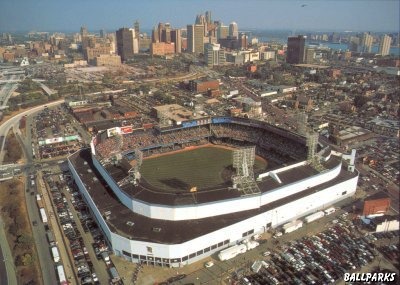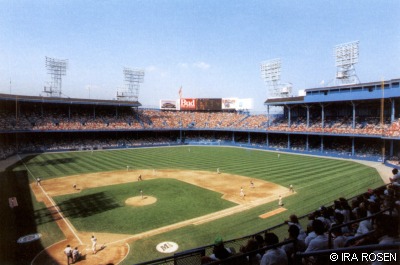Tiger Stadium
Detroit, MichiganTenant: Detroit Tigers (AL) Architect: Osborn Engineering Detroit Tigers tickets:
Location: 2121 Trumbull Avenue, in the Corktown neighborhood of downtown Detroit. Left field (NW), Cherry Street, later Kaline Drive, and Interstate 75; third base (SW), National Avenue, later Cochrane Avenue; first base (SE), Michigan Avenue; right field (NE), Trumbull Avenue. Dimensions: Left field: 345 (1921), 340.58 (1926), 339 (1930), 367 (1931), 339 (1934) 340 (1938), 342 (1939), 340 (1942); left-center: 365 (1942); center field: 467 (1927), 455 (1930), 464 (1931), 459 (1936), 450 (1937), 440 (1938), 450 (1939), 420 (1942), 440 (1944); right-center: 370 (1942), 375 (1982), 370 (current); right field: 370 (1921), 370.91 (1926), 372 (1930), 367 (1931), 325 (1936), 315 (1939), 325 (1942), 302 (1954), 325 (1955); backstop: 54.35 (1954), 66 (1955); foul territory: small. Fences: All fences: 5 concrete topped by screen; left field 20 (1935), 30 (1937), 10 (1938), 12 (1940), 15 (1946), 12 (1953), 14 (1954), 12 (1955), 11 (1958), 9 (1962); center field: 9 (1940), 15 (1946), 11 (1950), 9 (1953), 14 (1954), 9 (1955); right of flag pole: 7 (1946); right field: 8 (1940), 30 (1944), 10 (1945), 20 (1950), 8 (1953), 9 (1958), 30 (1961), 9 (1962); flag pole: 125 in play (5 feet in front of fence in center field, just left of dead center).
Tiger Stadium opened in 1912, the same day Boston opened Fenway Park, but baseball had been played on the site since 1896, five years before the Tigers or the American League existed. Navin Field, the original name of the park, was built on the site of old Bennett Park. It was named after owner Frank Navin, and it was renamed Briggs Stadium in 1938, two years after Walter Briggs took over the team. Briggs Stadium was renamed Tiger Stadium in 1961. The National Football League’s Detroit Lions moved in for a few decades, playing two NFL championship games at Tiger Stadium before leaving in 1975 for the nearby Pontiac Silverdome. Tiger Stadium’s best seats put fans as close to the action as any ballpark in the league. However, some of the lower-deck seats behind third base had their views of both the mound and home plate blocked by posts. In some of the seats, the upper deck blocked one's view of any ball hit in the air. Tiger Stadium was the playground for the likes of Lou Whitaker and Alan Trammell. Many remember Kirk Gibson homering off Goose Gossage in Game 5 of the 1984 World Series. Before that there was Al Kaline patroling right field and the 1968 World Series against the St. Louis Cardinals. Of course, in the early days, the ballpark hosted the Tigers of Ty Cobb and "Wahoo" Sam Crawford. There were a few modifications over the years, including various replacements of the center-field scoreboard and a large food court called Tiger Plaza (1993). However, the features that made Tiger Stadium unique remained. For many years, only Tiger Stadium had a flagpole in play (in center field). Its bullpens were set down each line, dugout style. The right field upper deck that hung out over the front row of the lower deck was so distinctive that the Texas Rangers copied the look (without an actual overhang) in 1994 for their new ballpark. Although plenty of home runs have ended up in Detroit’s right-field upper deck, only a few have traveled over it. Some have landed in the third-deck press box, 82 feet up, and some have made it even higher, out over the third deck’s 94-foot-high roof. Since the upper deck was extended to left and right field in 1938, 19 players have cleared the roof a total of 28 times. All but four of those sluggers - Harmon Killebrew in 1962, Frank Howard in 1968, Cecil Fielder in 1990 and Mark McGwire in 1997 - have hit the ball over the closer right-field roof. Tiger Stadium had a fan club whose goal was to keep baseball at the same site and in the same stadium. Members drew up their own plan for refurbishing Tiger Stadium, called the Cochrane Plan, but it was more or less ignored by the team and the city. A visit to the area around the stadium would help one understand why the team wanted to leave. Detroit is largely in ruins and about the only part of the city that looks to have any chance of thriving in the near future is the immediate downtown area. On July 24, 2001 an estimated crowd of 1,500 people attended a Great Lakes Summer Collegiate League game between the Motor City Marauders and the Lake Erie Monarchs. It was the first game played at the ballpark since the Tigers last game on September 27, 1999. Michigan & Trumbull, LLC, a local sports management company which organized the game, is seeking a short-term lease in order to bring a Frontier League franchise to Detroit to play games on nights when the Tigers are out of town.
Tiger Stadium Trivia:
More on Tiger Stadium: Recommended Reading (bibliography):
Help us provide a better web site by completing our feedback form IMAGES: Aerial view of Tiger Stadium © 1999 by Mike Smith. Updated July 2008 Tickets to Detroit Tigers, NCAA Basketball Tournament, College Football Bowl, NCAA Football, Paul McCartney and Wicked Detroit provided by Ticket Triangle. BALLPARKS © 1996-2014 by Munsey & Suppes.
|







